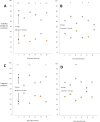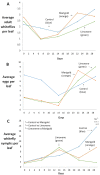Companion planting with French marigolds protects tomato plants from glasshouse whiteflies through the emission of airborne limonene
- PMID: 30822326
- PMCID: PMC6396911
- DOI: 10.1371/journal.pone.0213071
Companion planting with French marigolds protects tomato plants from glasshouse whiteflies through the emission of airborne limonene
Abstract
Horticulturalists and gardeners in temperate regions often claim that planting marigolds next to tomato plants protects the tomatoes from the glasshouse whitefly (Trialeurodes vaporariorum Westwood). If shown to hold true, this technique could be used in larger-scale tomato production, protecting the crop and helping to introduce greater plant diversity into these agro-ecosystems. Here we present two large-scale glasshouse trials corresponding to the two main ways growers are likely to use marigolds to control whiteflies. In the first, marigolds are grown next to tomato throughout the growing period and we quantify whitefly population growth from the seedling stage over a 48 day infestation period. Here we show that association with marigolds significantly slows whitefly population development. Introducing additional whitefly-attractive 'pull' plants around the perimeter of plots has little effect, but reducing the proportion of marigolds and introducing other non-hosts of whiteflies (basil, nasturtium and Chinese cabbage) also reduces whitefly populations on tomato. The second experiment assesses the efficacy of marigolds when used as an 'emergency' measure. Here we allow whitefly populations to build to a high density on unprotected tomatoes then introduce marigolds and assess whitefly population over a further period. Following laboratory work showing limonene to be a major chemical component of French marigolds and a negative behaviour response of whiteflies to this compound, limonene dispensers are added as an additional treatment to this experiment. "Emergency" marigold companion planting yielded minimal reductions in whitefly performance, but the use of limonene dispensers was more effective. Our work indicates that companion planting short vine tomatoes with French marigolds throughout the growing season will slow development of whitefly populations. Introducing marigolds to unprotected tomatoes after significant whitefly build-up will be less effective. The use of limonene dispensers placed near to tomato plants also shows promise. It is argued that this work supports the possibility of the development of a mixture of tomato companion plants that infer 'associational resistance' against many major invertebrate pests of tomato. Such a mixture, if comprising edible or ornamental plants, would be economically viable, would reduce the need for additional chemical and biological control, and, if used outdoors, would generate plant-diverse agro-ecosystems that are better able to harbour invertebrate wildlife.
Conflict of interest statement
The authors have declared that no competing interests exist.
Figures




References
-
- Rubatzky VE YM. World Vegetables: Principles, Production, and Nutritive Values Springer US,. Springer, US: Springer; 2012.
-
- Lange WH, Bronson L. Insect Pests of Tomatoes. Annu Rev Entomol. 1981;26:345–71. 10.1146/annurev.en.26.010181.002021 WOS:A1981KX79600014. - DOI
-
- Andi Nasruddin LAM. First record of Trialeurodes vaporariorum Westwood (Hemiptera: Aleyrodidae) severely damaging field grown potato crops in South Sulawesi, Indonesia. Journal of plant protection research. 2016;56(2).
-
- Wainaina JM, De Barro P, Kubatko L, Kehoe MA, Harvey J, Karanja D, et al. Global phylogenetic relationships, population structure and gene flow estimation of Trialeurodes vaporariorum (Greenhouse whitefly). B Entomol Res. 2018;108(1):5–13. 10.1017/S0007485317000360 WOS:000424027600002. - DOI - PubMed
-
- Jauset AM, Sarasua MJ, Avilla J, Albajes R. Effect of nitrogen fertilization level applied to tomato on the greenhouse whitefly. Crop Prot. 2000;19(4):255–61. 10.1016/S0261-2194(00)00016-8 WOS:000087225300006. - DOI
Publication types
MeSH terms
Substances
Grants and funding
LinkOut - more resources
Full Text Sources

